#caecilians
Text

AMPHIBIAN MILK!!
7K notes
·
View notes
Note
Do you have any tips for telling people my favorite amphibians are caecilians, without thinking I mean Sicilians?
Play them this: https://youtu.be/xxsUQtfQ5Ew?si=ZZLUOAYIxzb3EfVk
youtube
#I play this for my Animal Morphology class#among other things#always gets a smile or two#caecilians#answers by Mark#spontaneousmusicalnumber#highly relevant username
204 notes
·
View notes
Text

Reptiles, Amphibia, Fishes and Lower Chordata. Written by Richard Lydekker and others. Published in 1912.
Internet Archive
176 notes
·
View notes
Text

This is weird. Worms that produce milk.
141 notes
·
View notes
Text
Spooky Fact: The Worm that is ACTUALLY an Amphibian!
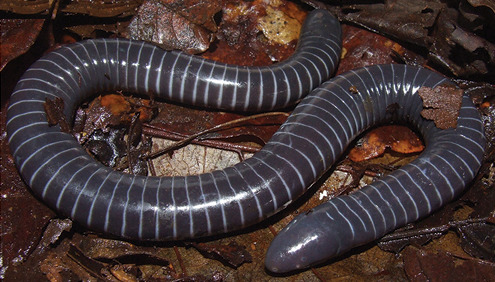
That^ is not a worm. It’s an amphibian.
Known as caecilians (pronounced seh-SILL-yens), these critters are unfamiliar to most people, and are also an excellent example of evolution trying to create ANOTHER worm (move over, crabs, worms are the REAL final form of evolution 😉).
These guys have SO MANY SPOOKY TRAITS! There’s slime, there’s scary teeth, and there’s even cannibalistic babies!
But let’s start with some decidedly un-spooky information. There are approximately 200 species of caecilians, all in the Order Gymnophiona, and all live in tropical and sub-tropical habitats around the world. That said, people don’t see them very often, because they spend most of their time hiding underground or in other seldom-seen locations. They range in size from ~9 cm to 1.5 m, and honestly, I like them so much.
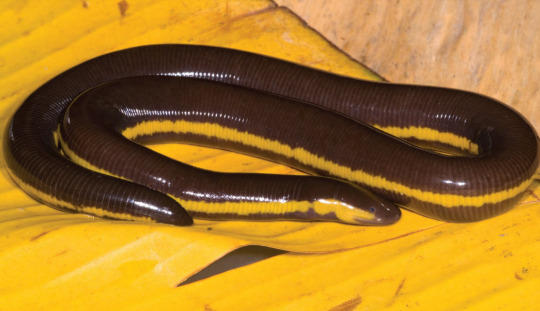
(Handsome baby! from Stuart et al. 2008)
Reportedly, their smooth, slimey skin makes them extremely hard to catch, and researchers have compared handling them to trying to handle a wet bar of soap (sources 1, 2).
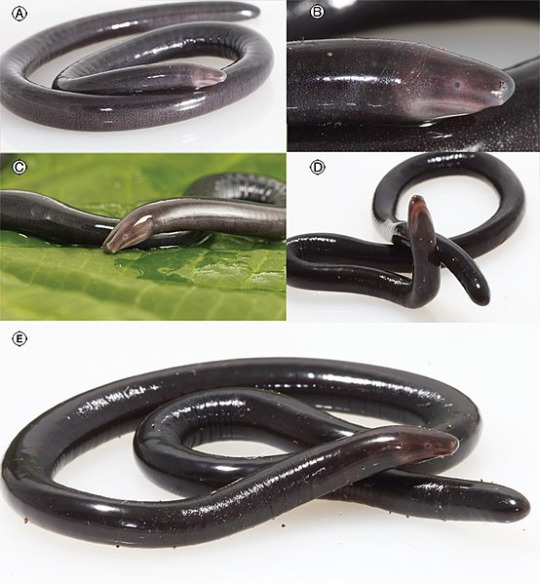
(the most slippy boi in the whole world probably <3)
Even though the word caecilians means “the blind ones”, they’re not actually blind (source x); they can differentiate light and dark, which COUNTS as sight (although if we’re defining blindness by “legal” blindness in humans, then… yeah, they would qualify as blind, I guess).
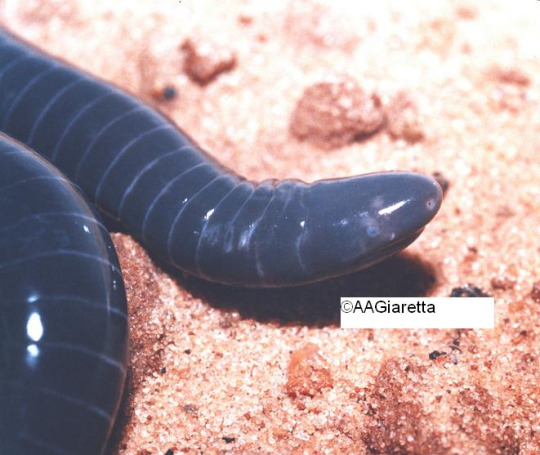
its eyes are small, but I PROMISE they work. they don’t work well, but they’re good enough for the caecilian’s needs.
Before I get to the spooky bit, I want to say that I find them to be quite lovely. They come in many colours, and I think they’re very sweet with their derpy sock puppet faces. Some species also have poisonous skin, which I, personally, respect so much (source of info: 3, source of respect: I’m happy for them).

Caecilians have such goofy faces.
that said, I have thus far been using images that purposefully highlight their cuteness and charm. There are other pictures which are... less flattering.
I’m actually going to put most of this Spooky Fact under the cut, because it is simply TOO SPOOKY.
(Seriously, though. If you dislike creepy teeth, skin shedding, and bite-y critters, maaaaybe give this one a pass. Read about oilbirds instead! They are wholesome and not too spooky)
Don’t say I didn’t warn you!

(These are not props on a scifi/horror movie set! This is what their teeth look like! x, x, x, and x).
While these teeth look very scary, caecilians are not dangerous to humans, instead favouring a diet of insects. One favourite food of many adult caecilians is termites!
However, in some species, the baby caecilians hunger for something else: THE FLESH OF THE LIVING.
Caecilians give more parental care to their offspring than most types of amphibians, with many species of momma caecilians curling around her brood of babies for the first part of their life.

(a loving momma with her babies; from Stuart et al. 2008; Alexander Kupfer)
It was originally believed that the caecilian mother exclusively fed her babies with a special liquid secretion from her tail. However, there was one thing that was strange:
Many baby caecillians have pointy little teeth that don’t seem well-suited to an all-liquid diet.


(Pointy teeth are suspicious. the picture of the baby is a little blurry, so here, have some pictures from a microscope as well, just to split the difference)
The presence of these temporary teeth were baffeling until scientists witnessed a feeding.
Guided by an unknown signal, the babies react all at once, latching onto their mother and tearing off and eating her skin in a practice known as maternal dermatophagy.

(they must FEED)
Luckily, this does not actually hurt the mother, since she is taking advantage of a process that all amphibians engage in: the periodical shedding of her skin.
Most amphibians will immediately eat their own shed skin, because they’re into that it’s rich in nutrients, so it isn’t a huge evolutionary leap to just... feed that skin to some babies instead.
When a caecilian mother is caring for a brood, she will shed her skin approximately every three days (source x). This shed skin is unusually rich with fats and proteins, which is very good for the diets of growing babies!

(great momma #2! x)
here’s a clip from BBC’s Life in Cold Blood that shows this feeding frenzy! They also get an awesome shot of the babies’ fearsome teeth!

(gosh I find them cute)
We don’t actually know how common this form of parental care is in caecilians, since, again: they like to hide. But, as of 2022, it has been observed in several species which are not closely related, which makes scientists think it must be pretty common! sources: x, x.

(this is a 100% inaccurate phylogenetic tree i made in <1 minute, showing basically what I’m talking about. The two confirmed skin-eating species had a common ancestor around 100 million years ago. sources for better, more detailed figures: x, x)
The other clue that hints that skin-eating may be fairly widespread? Those “baby teeth”!
We know that many caecilian species have vernal teeth, meaning they have special teeth when they’re babies which are not present in adults. I privately think of them as “baby teeth” because I cannot be arrested for it.
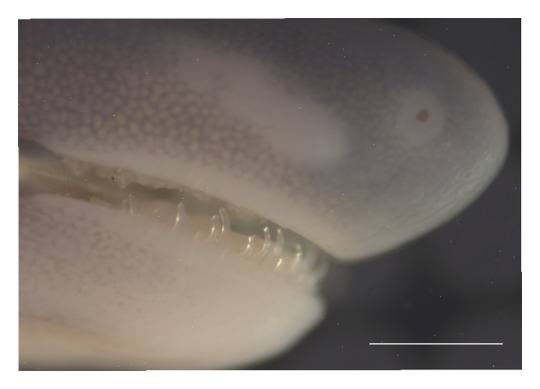
(friendly reminder that this baby is smol and cannot hurt u. That^ line in the picture? It’s there for scale and represents one milimetre. That’s 0.0394 inches for the americans in the room)
These “baby teeth” are known to be present in more than half of caecilian species examined in this paper. So, if these teeth are corelated that these species engage in maternal dermatophagy, then that implies that this form of parental care could be very widespread among caecilians!
This has been Spooky Fact Friday, telling you about the spooky amphibians that Hunger For Flesh!
bonus fact: ever since I learned out them, caecilians have always reminded me of this TV show that I watched as a kid called “Freaky Stories” that was co-hosted by this puppet:
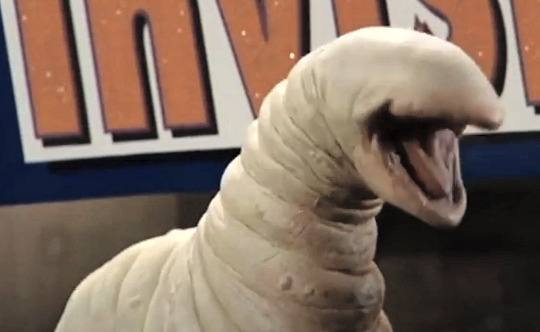
(actually it might still be on TV? wild)
also if you were wondering: yes, the once-viral “penis worm” is a type of caecilian.
sources, because I am an Extra Individual:
Kupfer, A., Müller, H., Antoniazzi, M. M., Jared, C., Greven, H., Nussbaum, R. A., & Wilkinson, M. (2006). Parental investment by skin feeding in a caecilian amphibian. Nature, 440(7086), 926-929.
Ruttimann, J. Amphibian 'worms' feed young their own flesh. Nature (2006). https://doi.org/10.1038/news060410-7
San Mauro, Diego; Gower, David J.; Müller, Hendrik; Loader, Simon P.; Zardoya, Rafael; Nussbaum, Ronald A.; Wilkinson, Mark (2014). Life-history evolution and mitogenomic phylogeny of caecilian amphibians. Molecular Phylogenetics and Evolution, 73(), 177–189. doi:10.1016/j.ympev.2014.01.009
Stuart, S.N., Hoffmann, M., Chanson, J.S., Cox, N.A., Berridge, R.J., Ramani, P., and Young, B.E. (eds.) (2008). Threatened Amphibians of the World. Lynx Edicions, Barcelona, Spain; IUCN, Gland, Switzerland; and Conservation International, Arlington, Virginia, USA.
Wilkinson M, Kupfer A, Marques-Porto R, Jeffkins H, Antoniazzi MM, Jared C. One hundred million years of skin feeding? Extended parental care in a Neotropical caecilian (Amphibia: Gymnophiona). Biol Lett. 2008 Aug 23;4(4):358-61. doi: 10.1098/rsbl.2008.0217
Moraes, L. J., de Almeida, A. P., de Fraga, R., Rojas, R. R., Pirani, R. M., Silva, A. A., ... & Werneck, F. P. (2017). Integrative overview of the herpetofauna from Serra da Mocidade, a granitic mountain range in northern Brazil. ZooKeys, (715), 103.
#biology#animals#halloween#science#amphibians#caecilians#sciblr#science side of tumblr#fun fact#STEM#adhd in STEM#zoology#fun fact friday#spooky#i am out of the country rn so don't expect much lmao
829 notes
·
View notes
Text
ribbit ribbit let's destroy linneaus some more
thanks to @quark-nova for the excellent clade options
205 notes
·
View notes
Link
Limbless, toothed, and worm-like, they spend their life burrowing through the soil, sensing the world with tentacles that protrude from between their eyes.
Little is known about these evasive creatures, or how they evolved. Fossils of only 11 species of ancestral caecilians have ever been found, so our understanding of how they are related to other amphibians, such as frogs and salamanders, is fragmented at best.
Now, a team of scientists from the US has uncovered a collection of tiny jawbones representing a new species that plugs a huge gap in the fossil record, revealing more about the unique features of modern-day caecilians and the evolutionary origins of moisty amphibians.
Continue Reading
123 notes
·
View notes
Text
kinda fucks me up that while caecilians tend to just look like weird big vertebrate worms, their skulls look like *this*

do you see those teeth? the ungogly length of the lever on the lower jaw? these jaws are absurd, if these things got bigger they'd be terrifying
for reference they look like this

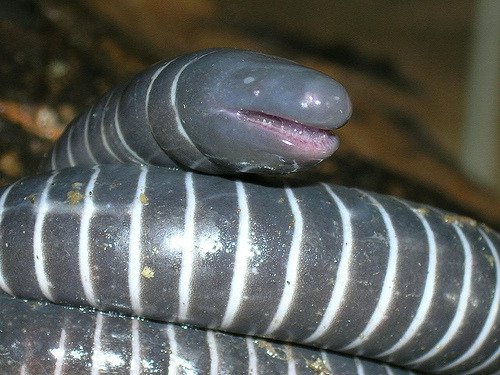
funky little worms with shark-tier jaws
5 notes
·
View notes
Text



caecilian eggs
2 notes
·
View notes
Note
can you check this post please? the video doesn't link specific sources so idk if it's all factual https://www.tumblr.com/northern-punk-lad/713154899628687360/this-is-exactly-what-i-mean-when-i-say-the-society
checking this out now!
9 notes
·
View notes
Video
youtube
(via Episode 162 – Caecilians)
1 note
·
View note
Text

The range of amphibian forms from The Life of Animals with Backbones; Foundations of Vertebrate Zoology. Written by Michael Gabb. 1966.
#prehistoric#prehistoric amphibians#ichthyostega#eryops#amphibians#mudpuppies#newts#salamanders#ambystoma#toads#common toads#surinam toads#frogs#tree frogs#common frogs#caecilians#Haywood
322 notes
·
View notes
Text
Animal practice 5
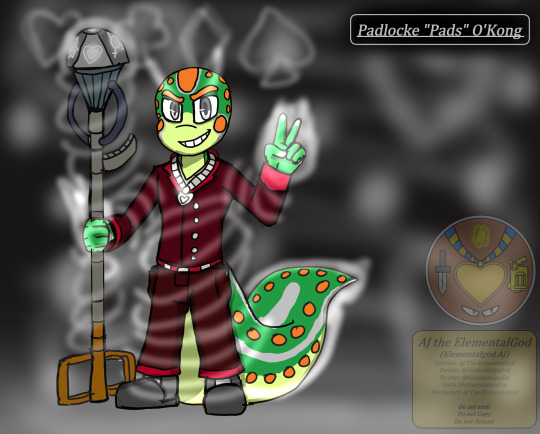





Amphibians
Frogs
Pads (Goliath frog/tree frog)
Tox-ina (poison dart frog)
Toads
Croaker (cane toad/common toad mix)
Salamanders
Ridgid (Newt)
Axanthic (Giant Salamander/Axolotl)
Caecilians
Daisy (Mexican burrowing caecilian)
#the watchful eye#watchful eye#my art#my oc#my ocs#aj the elementalgod#elementalgod aj#toonverse oc#isle 0#o'kong family#neo demons#anthro allies#earthdemons#amphibians#frogs#toads#salamanders#caecilians#axolotl
2 notes
·
View notes
Text
Edited the caecilian article for Lemuria: https://lemuriaspeculative.wordpress.com/2023/03/13/caecilians-of-lemuria/
#caecilians#caecilian#lemuria#spec evo#speculative evolution#speculative biology#speculative zoology
0 notes
Text
Typhlonectid amphibians
Often mistraded as a "rubber eel", the Rio Cauca caecilian (Typhlonectes natans) is actually an aquatic member, of a primarily fossorial, and non-aquatic clade of vertebrates, the Gymnophiona or caecilians. The confused appellation of "Sicilian worm" is attested, in North American aquarium retail, but these are neither worms nor eels. Rather, they are amphibians, though there is some debate, as to where Gymnophiona fits in the amphibian tree. The bulk of evidence would have Gymnophiona and their fossil relatives, the Albanerpetonidae, as sister to the salamanders, Urodela - forming a descent group, named Procera, that excludes the frogs, Anura.
Ublike their relatives that burrow, the typhlonectids are natural inhabitants of acidic to circum-neutral freshwaters, in the Neotrooical Realm. Ecologically, they are scavengers similar to marine hagfishes, swarming around carrion, and even sharing with them, through convergent evolution, a similar defensive slime coating. Typhlonectes natans also forages prey such as insects, shrimp, frog tadpoles, frogspawn, and small fish. This foraging habit leads to much detritus in their guts, and it is unknown wether Typhlonectes ingest detritus deliberately, or digest decaying plant material for its nutrients. Probably, it is ingested accidentally, in the course of foraging. T. natans grows to around 50 cm (20 in) long.
In the aquarium, T. natans like a high temperture, as befits their origins in northeastern South America. However tempertures over 30 degrees, can induce heat stress on these animals, so 26-31 degrees centigrade is a fair approximation, of their wild habitats. A pH between 6 and 7 would also reflect the locations, where T. natans has been collected in the wild. Sudden drops is in pH can be harmful to these amphibians, and the dH must be less than 5.6. Just about any defrosted, meaty food is eaten, but fast swimming fish sharing their aquarium, may outcompete the caecilians for it. It is best to feed them at night, because they are nocturnal, and forage primarily by oflaction. Quite unsurprisingly for such a generalised carnivore, T. natans also consumes singing pellets in the aquarium.
The aquarium layout should feature a soft substrate, deep enough for these animals to burrow in, and hiding places such as bogwood. The decor should be rough textured, but not sharp, because Typhlonectes rub on items in their environment, to shed their skins. T. natans is often found, amid aquatic vegetation, including floating plant life. In the aquarium, this species benefits from floating plants, because it will use them for shelter, and they diffuse the light from above. Though T. natans are gregarious by nature, the males can be nippy towards one another, and even to female tankmates. Small fish such as neon tetras, might not be safe from these opportunists come night time, so all tankmates of T. natans, must exceed the size of their heads, to be on the safe side. Interestingly, T. natans has been housed productively, with the Surinam toad, Pipa pipa.
0 notes
Text

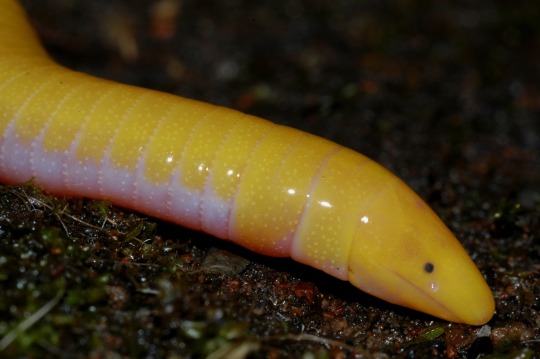
São Tomé Caecilian (Schistometopum thomense), family Dermophiidae, endemic to São Tomé and Ilhéu das Rolas (Africa)
photographs by m_burger
25K notes
·
View notes